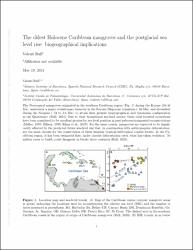Mostrar el registro sencillo del ítem
The oldest Holocene Caribbean mangroves and the postglacial sea level rise : biogeographical implications
| Autor | Rull, Valentí | |
| Fecha de admisión | 2024-06-06T23:59:32Z | |
| Fecha disponible | 2024-06-06T23:59:32Z | |
| Año | 2024 | |
| Citación | Rull, V. (2024). The oldest Holocene Caribbean mangroves and the postglacial sea level rise: biogeographical implications [preprint]. ESS Open Archive. Recuperado de: | es |
| URI | https://bvearmb.do/handle/123456789/4666 | |
| Sinopsis | The Neotropical mangroves originated in the southern Caribbean region during the Eocene (50-40 Ma), underwent a major evolutionary turnover in the Eocene/Oligocene transition (~34 Ma), and diversified during the Neogene (~23 to 2.6 Ma), to attain their present biogeographical and taxonomic configuration in the Quaternary. Due to their transitional sea-land nature, these tidal forested ecosystems have been considered to be excellent proxies for sea-level position in past paleoenvironmental reconstructions. For the same reason, mangroves are expected to be significantly affected by the predicted future sea-level rise that, in combination with anthropogenic deforestation, are the main threats for the conservation of these singular tropical/subtropical coastal forests. In the Caribbean region, it has been estimated that, under current deforestation rates, what has taken evolution ~50 million years to build, could disappear in barely three centuries... | es |
| Idioma | English | es |
| Publicado | ESS Open Archive [preprint] | es |
| Derechos | © The author. | es |
| Materia | Recursos naturales | es |
| Materia | Recursos costeros y marinos | es |
| Materia | Paleobiología | es |
| Título | The oldest Holocene Caribbean mangroves and the postglacial sea level rise : biogeographical implications | es |
| dc.identifier.doi | https://doi.org/10.22541/essoar.171535600.04701866/v1 | |
| Tipo de material | Article | es |
| Tipo de contenido | Scientific research | es |
| Acceso | Open | es |
| Audiencia | Technicians, professionals and scientists | es |
Ficheros en el ítem
Este ítem aparece en la(s) siguiente(s) colección(es)
-
Investigación ambiental [1759]


